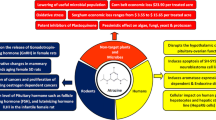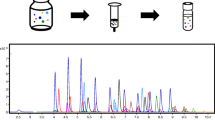Abstract
The earthworm represents a kind of creature in contact with the soil surface and usually exposed to a variety of organic pollutants from human activities. Therefore, it can be considered as an organism of choice for identifying pollution or better understanding the input of contaminants in food chains in particular through the contributions of sludge. Moreover, the use of organisms such as soil invertebrates is to be developed for ecotoxicological risk assessment of pollutants. In this context, a simple, rapid and effective multi-residue method was developed for the determination of 31 compounds including 11 steroids, 14 veterinary antibiotics and 6 human contaminants (paracetamol, sulfamethoxazole, fluvoxamine, carbamazepine, ibuprofen, bisphenol A) in earthworm. The sample preparation procedure was based on a salting-out extraction with acetonitrile (QuEChERS approach) that was optimised with regard to the acetonitrile/water ratio used in the extraction step, the choice of the clean-up and the quantity of the matrix. The optimised extraction method exhibited recoveries that comprised between 44 and 98 % for all the tested compounds. The limits of detection of all compounds were below 14 ng g−1 and the limits of quantification (LOQ) comprised between 1.6 and 40 ng g−1 (wet weight). The method was therefore applied to determine the levels of pharmaceuticals and hormones in six earthworm samples collected in various soils. Concentrations up to 195 ng g−1 for bisphenol A were determined, between a few nanograms per gram and 43.1 ng g−1 (estriol) for hormones and between a few nanograms per gram and 73.5 ng g−1 (florfenicol) for pharmaceuticals. Experiments were also conducted in laboratory conditions to evaluate the accumulation of the target substances by earthworm.





Similar content being viewed by others
References
Kumar K, Gupta SC, Chander Y, Singh AK (2005) Antibiotic use in agriculture and its impact on the terrestrial environment. In: Advances in Agronomy, volume 87, Elsevier, pp 1–54
Johnson A, Jurgens M (2003) Endocrine active industrial chemicals: release and occurrence in the environment. Pure Appl Chem 75:1895–1904
Shore LS, Shemesh M (2003) Naturally produced steroid hormones and their release into the environment. Pure Appl Chem 75:1859–1871
Diercxsens P, Tarradellas J (1987) Soil contamination by some organic micropollutants related to sewage sludge spreading. Int J Environ Anal Chem 28:143–159
Suthar S, Singh S (2009) Bioconcentrations of metals (Fe, Cu, Zn, Pb) in earthworms (Eisenia fetida), inoculated in municipal sewage sludge: do earthworms pose a possible risk of terrestrial food chain contamination? Environ Toxicol 24:25–32
Suthar S (2008) Metal remediation from partially composted distillery sludge using composting earthworm Eisenia fetida. J Environ Monit 10:1099–1106
Kinney CA, Furlong ET, Kolpin D, Burkhardt MR, Zaugg SD, Werner SL, Bossio JP, Benotti MJ (2008) Bioaccumulation of pharmaceuticals and other anthropogenic waste indicators in earthworms from agricultural soil amended with biosolid or swine manure. Environ Sci Technol 42:1863–1870
Macherius A, Lapen DR, Reemtsam T, Römbke J, Topp E, Coors A (2014) Triclocarban, triclosan and its transformation product methyl triclosan in native earthworm species four years after a commercial-scale biosolids application. Sci Total Environ 472:235–238
Bouche A (1992) In: Greig-Smith PW, Becker H, Edwards PJ, Heimbach F (eds) Ecotoxicology of earthworms. Intercept, Andover, pp 20–35
VICH (International Cooperation on Harmonization of Technical Requirements for registration of Veterinary Medicinal Products), GL (2004) Environmental impact assessments (EIAs) for veterinary medicinal products—phase II. CVMP/VICH/790/03. European Medicine Evaluation Agency, London
Carter LJ, Garman CD, Ryan J, Dowle A, Bergström E, Thomas-Oates J, Boxall ABA (2014) Fate and uptake of pharmaceuticals in soil-earthworm systems. Environ Sci Technol 48:5955–5963
Zhao S, Zhu L, Liu L, Liu Z, Zhang Y (2013) Bioaccumulation of perfluoroalkyl carboxylates (PFCAs) and perfluoroalkane sulfonates (PFSAs) by earthworm (Eisenia fetida) in soil. Environ Pollut 179:45–52
Wang H, Chen J, Guo B-Y, Li J (2014) Enantioselective bioaccumulation and metabolization of diniconazole in earthworms (Eisenia fetida) in an artificial soil. Ecotoxicol Environ Saf 99:98–104
Chen J, Wang H-L, Guo B-Y, Li J-Z (2014) LC-MS/MS method for simultaneous determination of myclobutanil, hexaconazole, diniconazole, epoxiconazole and tetraconazole enantiomers in soil and earthworms. Int J Environ Anal Chem 94:791–800
Kinney CA, Campbell BR, Thompson R, Furlong ET, Kolpin DW, Burkhardt MR, Zaugg SD, Werner SL, Hay AG (2012) Earthworm bioassays and seedling emergence for monitoring toxicity, aging and bioaccumulation of anthropogenic waste indicator compounds in biosolids-amended soil. Sci Total Environ 433:507–515
Anastassiades M, Lehotay SJ, Štajnbaher D, Schenck FJ (2003) Fast and easy multiresidue method employing acetonitrile extraction/partitioning and “dispersive solid-phase extraction” for the determination of pesticide residues in produce. J AOAC Int 86:412–431
Stubbings G, Bigwood T (2009) The development and validation of a multiclass liquid chromatography tandem mass spectrometry (LC-MS/MS) procedure for the determination of veterinary drug residues in animal tissue using a QuEChERS (QUick, Easy, CHeap, Effective, Rugged and Safe) approach. Anal Chim Acta 637:68–78
Abdallah H, Arnaudguilhem C, Jaber F, Lobinski R (2014) Multiresidue analysis of 22 sulfonamides and their metabolites in animal tissues using quick, easy, cheap, effective, rugged, and safe extraction and high resolution mass spectrometry (hybrid linear ion trap-Orbitrap). J Chromatogr A 1355:61–72
Wiest L, Bulete A, Giroud B, Fratta C, Amic S, Lambert O, Pouliquen H, Arnaudguilhem C (2011) Multi-residue analysis of 80 environmental contaminants in honeys, honeybees and pollens by one extraction procedure followed by liquid and gas chromatography coupled with mass spectrometric detection. J Chromatogr A 1218:5743–5756
Norli HR, Christiansen A, Deribe E (2011) Application of QuEChERS method for extraction of selected persistent organic pollutants in fish tissue and analysis by gas chromatography mass spectrometry. J Chromatogr A 1218:7234–7241
Orlando EA, Simionato AVC (2013) Extraction of tetracyclinic antibiotic residues from fish filet: comparison and optimization of different procedures using liquid chromatography with fluorescence detection. J Chromatogr A 1307:111–118
Berlioz-Barbier A, Buleté A, Faburé J, Garric J, Cren-Olivé C, Vulliet E (2014) Multi-residue analysis of emerging pollutants in benthic invertebrates by modified micro-quick-easy-cheap-efficient-rugged-safe extraction and nanoliquid chromatography-nanospray-tandem mass spectrometry analysis. J Chromatogr A 1367:16–32
Salvia MV, Vulliet E, Wiest L, Baudot R, Cren-Olivé C (2012) Development of a multi-residue method using acetonitrile-based extraction followed by liquid chromatography-tandem mass spectrometry for the analysis of steroids and veterinary and human drugs at traces level in soil. J Chromatogr A 1245:122–133
(2005) ICH Harmonised Tripartite Guideline, validation of analytical procedures: text and methodology Q2(R1). International conference on harmonisation of technical requirements for registration of pharmaceuticals for human use
Bruzzoniti MC, Checchini L, De Carlo RM, Orlandini S, Rivoira L, Del Bubba M (2014) QuEChERS sample preparation for the determination of pesticides and other organic residues in environmental matrices: a critical review. Anal Bioanal Chem 406:4089–4116
Fernandes D, Loi B, Porte C (2011) Biosynthesis and metabolism of steroids in molluscs. J Steroid Biochem 127:189–195
Boleas S, Alonso C, Pro J, Mar Babin MM, Fernandez C, Carbonell G, Tarazona JV (2005) Effects of sulfachlorpyridazine in MS 3-arable land: multispecies soil system for assessing the environmental fate and effects of veterinary medicines. Environ Toxicol Chem 24:811–819
Acknowledgments
The authors thank the ADEME (Agence de l’Environnement et de la Maîtrise de l’Energie) for the ARCOS programme funding (no. 10 94 C 0076).
Conflict of interest
The authors declare that they have no competing interests.
Ethics approval
The authors declare that the experiments were conducted in accordance with animal care.
Author information
Authors and Affiliations
Corresponding author
Rights and permissions
About this article
Cite this article
Bergé, A., Vulliet, E. Development of a method for the analysis of hormones and pharmaceuticals in earthworms by quick, easy, cheap, effective, rugged and safe (QuEChERS) extraction followed by liquid chromatography-tandem mass spectrometry (LC-MS/MS). Anal Bioanal Chem 407, 7995–8008 (2015). https://doi.org/10.1007/s00216-015-8972-z
Received:
Revised:
Accepted:
Published:
Issue Date:
DOI: https://doi.org/10.1007/s00216-015-8972-z




